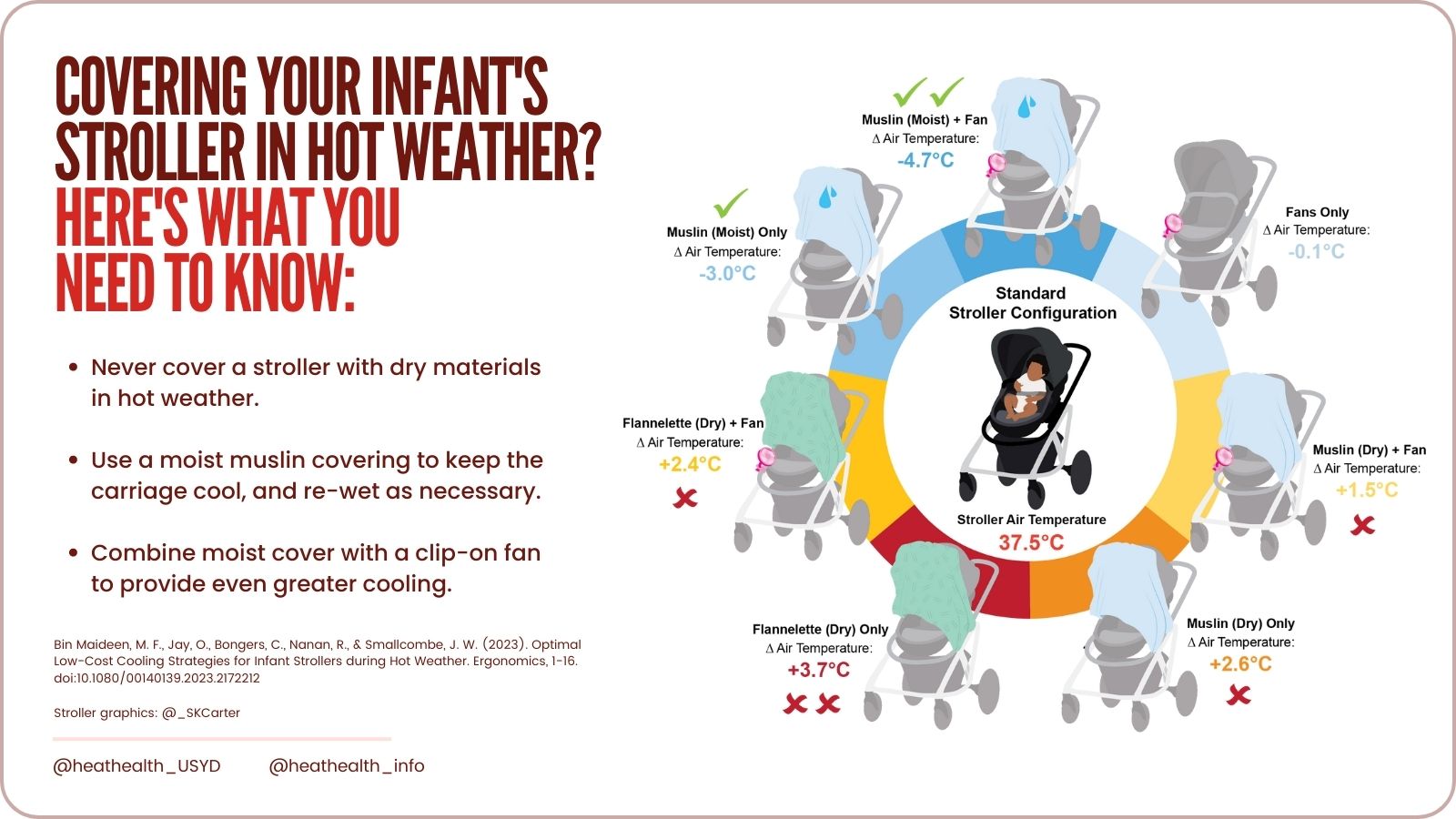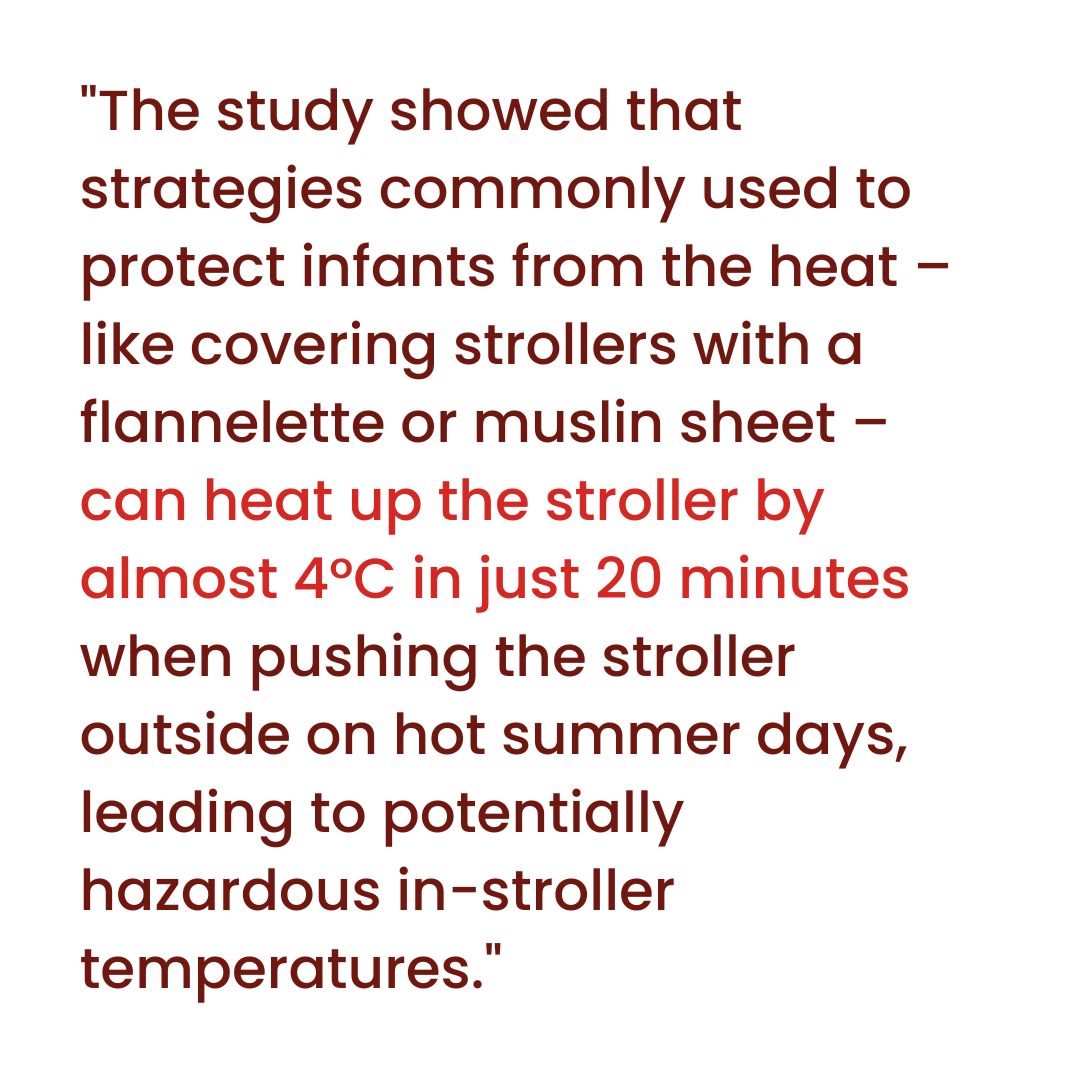Covering an infant stroller in hot weather? Here’s what you need to know.
Published: February 13, 2023
Researchers from the Heat and Health Research Incubator at the University of Sydney have recently published a paper exploring the best methods of keeping infant prams and strollers cool during hot summer weather. The study, published in the journal Ergonomics, used the latest environmental monitoring techniques to research and recommend the most low-cost and practical approaches for keeping young ones cool in a stroller while out and about. In this article authors James Smallcombe and Ollie Jay address some of the key questions emerging from this research.

Why did you undertake this study?
Babies and infants may be particularly vulnerable to the summer heat due to a more limited thermoregulatory capacity compared with adults, which means they are more likely to be negatively impacted by heat stress exposure. Furthermore, parents are responsible for exclusively managing the heat stress risk and thermal comfort of their infants and are required to make good day-to-day decisions. For example, when out in the heat, parents need to choose clothing that is suitable for the weather, ensure their child is shaded from the sun and seek cool shelter when needed. Unfortunately, the issue of infant heat stress is often neglected in public heath recommendations and very little research evidence exists regarding the most effective ways of keeping infants cool and comfortable when out in a stroller. This study aimed to fill some of these gaps and provide evidence-based recommendations to help parents beat the heat and protect their infants.
What were the main findings of this study?
The study showed that strategies commonly used to protect infants from the heat – like covering strollers with a flannelette or muslin sheet – can heat up the stroller by almost 4°C in just 20 minutes when pushing the stroller outside on hot summer days, leading to potentially hazardous in-stroller temperatures. Dr James Smallcombe who is senior author on the paper said “these findings reiterate the message that parents should avoid the temptation to cover the stroller with dry materials and should instead opt for alternative methods that keep strollers cool. Many parents don’t realise that well-intended attempts to shade their babies while in a stroller may in fact increase the risk of overheating.”
The study showed that the most effective method of keeping the internal temperature of a stroller in check was draping a fully moistened muslin cloth over the stroller whist also attaching a clip-on fan to the stroller frame to help ventilate the stroller carriage. Not only did this method reduce the internal stroller temperature by almost 5°C, but it was also effective in substantially reducing the wet bulb globe temperature (WBGT); an index which integrates temperature, radiation, humidity and wind speed to provide an assessment of the overall level of heat stress. Professor Ollie Jay explained “this method works by promoting the evaporation of water from the moist muslin cloth, which in turn cools the air inside the stroller. This is particularly effective when coupled with a fan as this the increases the airflow through the carriage and results in extra evaporative heat loss”.

Why do dry coverings increase the stroller temperature?
Whilst covering the stroller with a dry material provides some shade, solar radiation is still able to penetrate the cloth and enter the stroller carriage. Importantly, a dry covering reduces the amount of airflow that passes through the stroller, which leads to this radiant heat being absorbed and retained in the stroller. Over time, this causes the stroller to gradually heat up, leading to in-stroller temperatures that are much higher than those experienced outside. A similar phenomenon is often observed in cars when parked in the sun with the windows closed.
How wet should the coverings be?
It is recommended that the coverings should be fully saturated with water but wrung-out so that the water is not dripping into the stroller. Regularly re-moistening the cloth using a simple water spray bottle can help prevent it drying out and help increase the length of time this cooling method remains effective.
What other methods can be combined with the findings from your study to maximize cooling in strollers?
In addition to the strategies tested during this study, parents are also encouraged to dress infants in light and loose clothing, avoid taking the stroller out during the hottest period of the day (especially when the sun is at its strongest between noon and 3pm), limit the amount of time spent outside before seeking cool refuge, and to regularly check infants for signs of heat stress which include: being overly warm to touch; hot, red and dry skin; irritability; and looking generally unwell and/or lethargic. Additionally, parents should never leave the stroller stationary in the sun as this is when the risk of overheating is greatest. Parents should also move as quickly as possible between locations to limit the amount of time the stroller is out in the heat.
Are the findings of this study also relevant to locations where it is very humid?
In very humid environments, the wet draping may be less effective when the stroller is stationary as the evaporation of water may be hindered. However, providing the stroller is moving and the conditions permit the water to evaporate from the material, a cooling effect will be achieved. In this study, the stroller cooling interventions were tested in Sydney, Australia across 16 different days with an average ambient temperature of 33°C with 37% relative humidity, which is considered hot and moderately humid weather. However, on some of these days the relative humidity was as high as 60% (at 32°C) – in these more humid conditions the wet muslin covering in combination with a clip-on fan was still effective in cooling the stroller.
Dr. James Smallcombe is a post-doctoral research fellow in Heat and Health Research Incubator in the Faculty of Medicine and Health at The University of Sydney. James leads several research projects aimed at increasing human resilience to extreme heat events. James’ main expertise is in paediatric thermoregulation and protecting vulnerable populations against the negative impacts of heat stress during day-to-day activities.

Professor Ollie Jay is Director of the Heat and Health Research Incubator in the Faculty of Medicine and Health at The University of Sydney. His research activities primarily focus on developing a better understanding of the physiological and physical factors that determine human heat strain and the associated risk of heat-related health problems during work and/or physical activity, as well as among the general population during heat waves. He is a NHMRC Investigator Grant (Leadership Level 1) recipient for his research program entitled “Heat and Health: Building resilience to a warming planet across the human lifespan”
